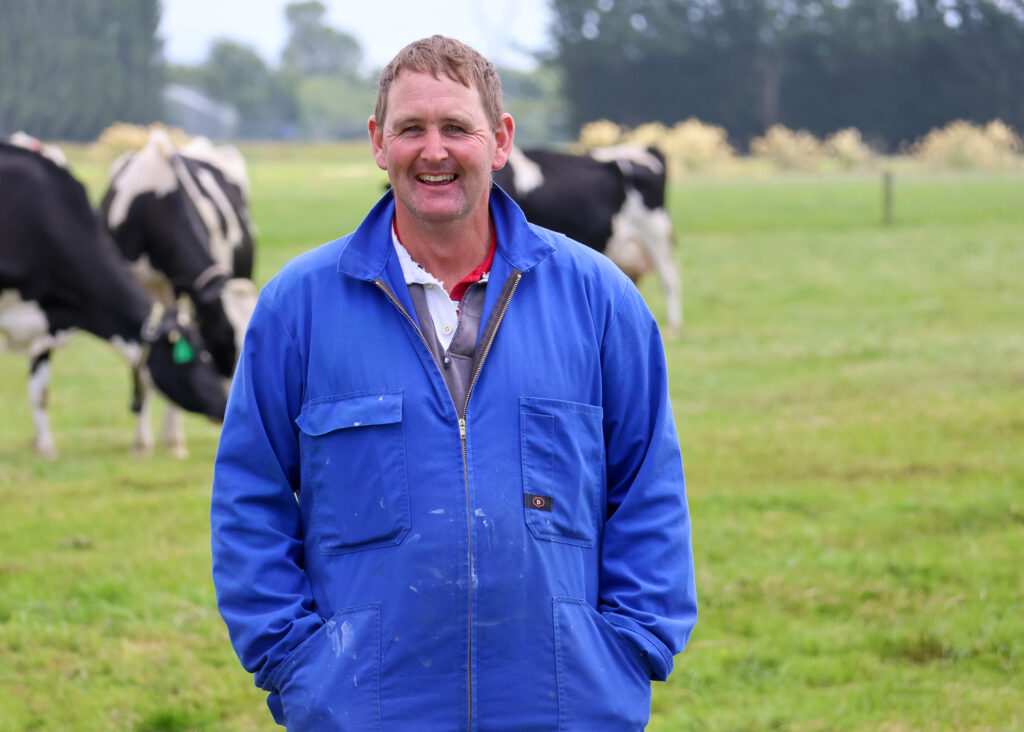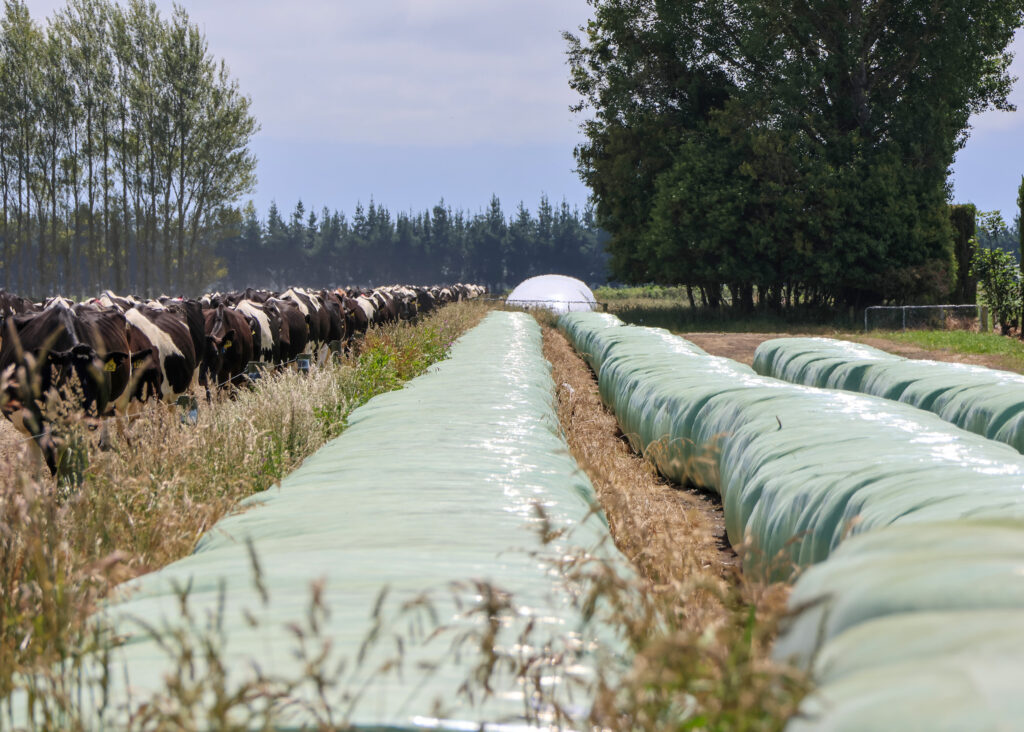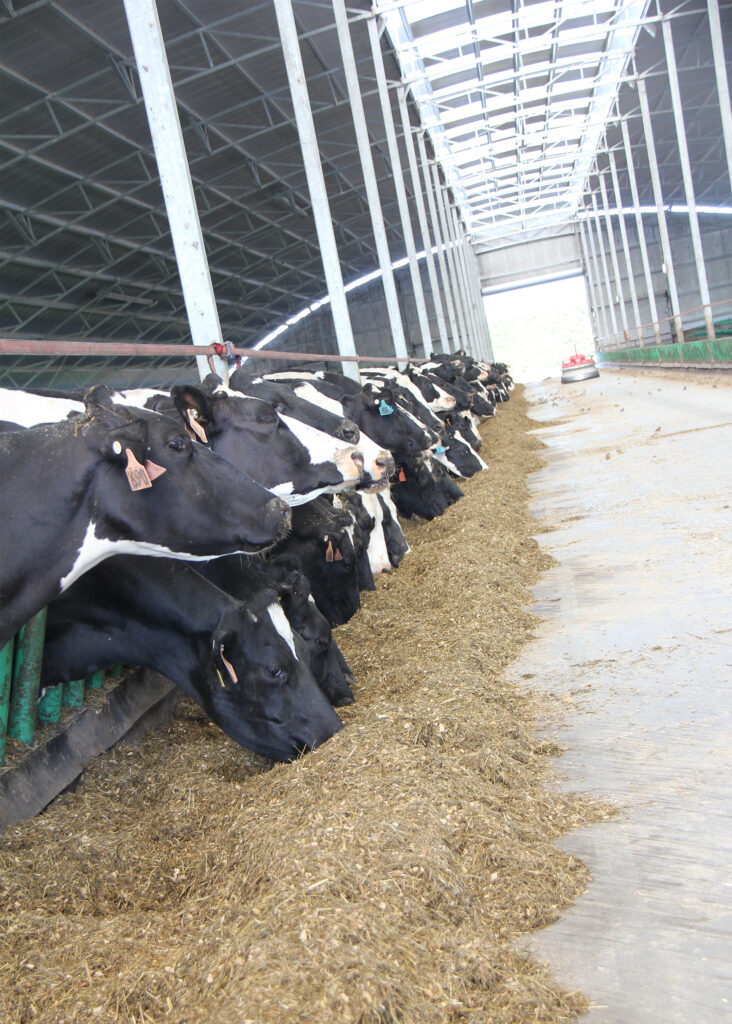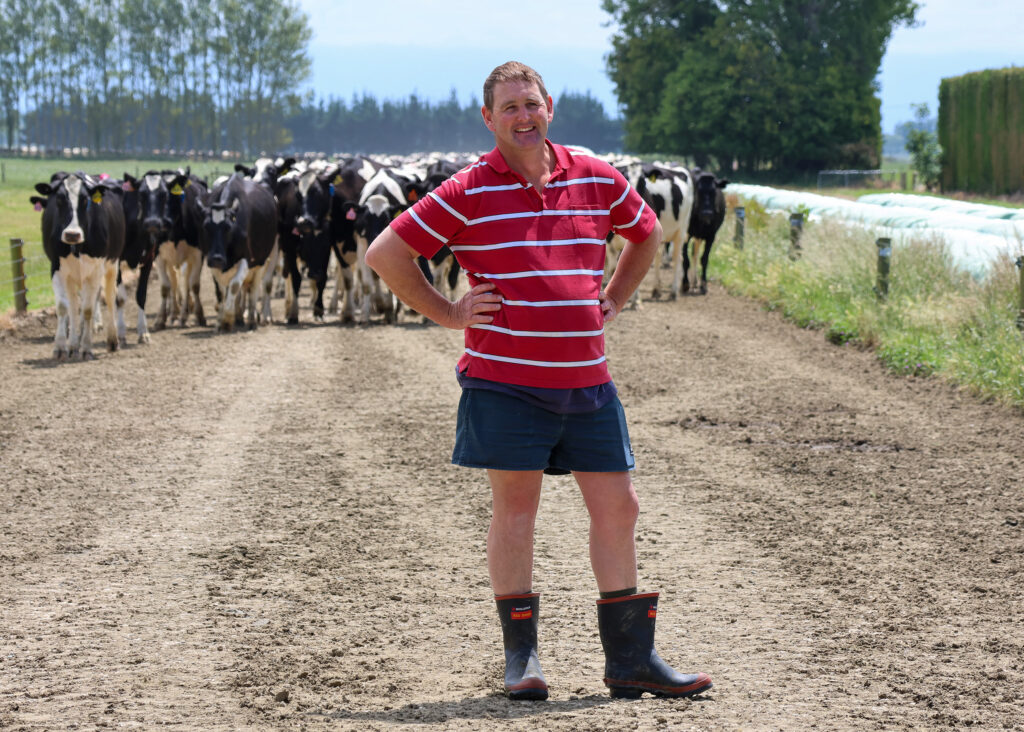Mark Stewart knows when he conserves feed, he’s adding to his production costs.

Mark Stewart is charged with making sure the operation has enough feed reserves to sustain their 550-cow herd year-round.
Brothers TJ and Mark – together with Mark’s wife Stacey – milk 550 cows close to Ashburton in Mid Canterbury in a lease agreement with the brothers’ parents, David and Maree.

Mark, Stacey, and TJ Stewart run Barwell Farm together.
Barwell Holsteins produces 330,000kg Milk Solids (MS) – averaging 600kgMS/cow on a 70% autumn-calving pattern.
Between April and September, the family houses the milking herd in a 140m x 75m barn, which was built in 2013. The barn was a contentious decision at the time, but it is now a central part of the family’s ability to harness premium winter milk contracts.
It also helped them navigate and sustain production in 2021 during the region’s one-in-200-year flooding – which temporarily buried 14.5ha of their farm under riverbed rubble – impacting 50ha (including wiping out 15km of fencing).
Maintaining feed quality while making winter milk – and protecting sodden paddocks through those months – is key to achieving a quick getaway in the spring for their spring-calving cows. It means that between May and September, this family depends on the quality of their conserved feed – delivered to the milking herd as a Total Mixed Ration.
Last year they made 770 (T) tonnes of maize silage (370T pit/370T long tubes). They also made an additional 250T of Lucerne silage, and 250T of grass silage in long tubes.
Efficient, different, and cost-effective

The spring-calving herd is run on pasture while the winter milking herd spends five months milking out of the operation’s barn.
The family is constantly looking for more efficient and cost-effective ways to improve their results. That includes silage preservative. Last season, they used the preservative Silo Guard II®. It offered a different mode of action, and it was up to 1c/kg Dry Matter (DM) cheaper than the competition.
Unlike traditional preservative, it does not super-populate the silage with additional bacteria.
Rather, it is a sulphur-based preservative which steals oxygen – rapidly shutting down the aerobic process in the stack. By scavenging oxygen, the crop achieves an anaerobic condition quickly, allowing the good bacteria to grow and produce lactic acid. It also means less nutrients and crop are lost during ensiling.
A second advantage Silo Guard II has is that it can be sprayed on an open bunker face at a rate of 400ml/tonne after each feeding, which continues to provide a protective shield for the silage’s anaerobic state and palatability.
“Less mould equals less wastage, and that’s what we’re all about,” Mark said. “We’d gone down the road of triple covering the silage, but it’s an extra cost, and we have used a standard preservative before.
“Silo Guard was different.”
Asked and answered

The Stewart family makes 1270T of silage every year to sustain its year-round milking operation.
Mark said everything Silo Guard II promised had been delivered.
“I’d estimate we had 10-15% less wastage in the tubes and in the pit – so that gives us around 20-30% less feed wastage overall,” Mark said.
“I didn’t know what to expect when we opened the silage to feed it out, but we were really pleased. The silage was sweet. Whether that’s because it’s more sugary or not, I’m not sure. But the colour of the silage was quite bright, and well preserved.
“I also noticed that when we’ve used other preservatives that the cows in the barn didn’t eat the silage after three or four days because it started to heat up and sour.
“We didn’t notice that same heating in the silage that had been treated with Silo Guard, so the feed maintained its palatability and the cows definitely ate it for longer.
“That gave us another hit of feed savings at the feeding out stage.”
The Stewart family transitions their milking herd at each end of the season from summer pasture life back into barn living and vice versa. They offer silage in the paddock during that changeover period. Last spring during the transition, Mark noticed another positive choice the cows had made for him.
“In the period where we feed it out before they get to the paddock, I found they’d go straight to the maize silage before going back to the grass. It was unusual during spring that they would choose silage over grass. We hadn’t noticed that before.
“They were also eating it all. There was no wastage out there, and the silage didn’t scald the pasture.”
Their “why”

Premium winter milk prices were able to be taken advantage after Barwell Farm built a barn in 2013.
Mark said he was clear about why he decided to give Silo Guard II a try.
“I liked the science, and I liked what Charlotte [Flay, Dairy Business Centre] was telling me about the product.”
Charlotte noted that Silo Guard II’s mode of action offered several layers of other useful advantages.
“Without that oxygen, mould, and yeast (heating), the bacterial growth is controlled – even at higher moisture levels,” she said. “Stalks hold little pockets of air, and you can’t do anything about that.
“But if you bale at 20% moisture, with Silo Guard II you will have increased leaf retention, and you’ll harvest more (higher quality) hay or silage/hectare.”
Ready mixed

Mark Stewart is charged with making sure the operation has enough feed reserves to sustain their 550-cow herd year-round.
The product comes ready mixed, so there are no unpleasant mixing conversations.
“Other inoculants we’ve had to pre-mix in a dark place, and what you mix you have to use,” Mark said.
“At the end, our guy can now control the flow rate and if he is getting to the end of the paddock, he can just up the rate a little bit, so it’s all gone.
“You do just have to remember to clean your machines thoroughly after applying it.”
Mark said Silo Guard II had ticked all the right boxes for their operation.
“In this market right now, the 1c/kg MS price point advantage is important, as well as the return on investment. Even if someone was to price-match it now, I wouldn’t switch, because we are impressed with the results, and the price is right.
“It doesn’t get better than that.”







